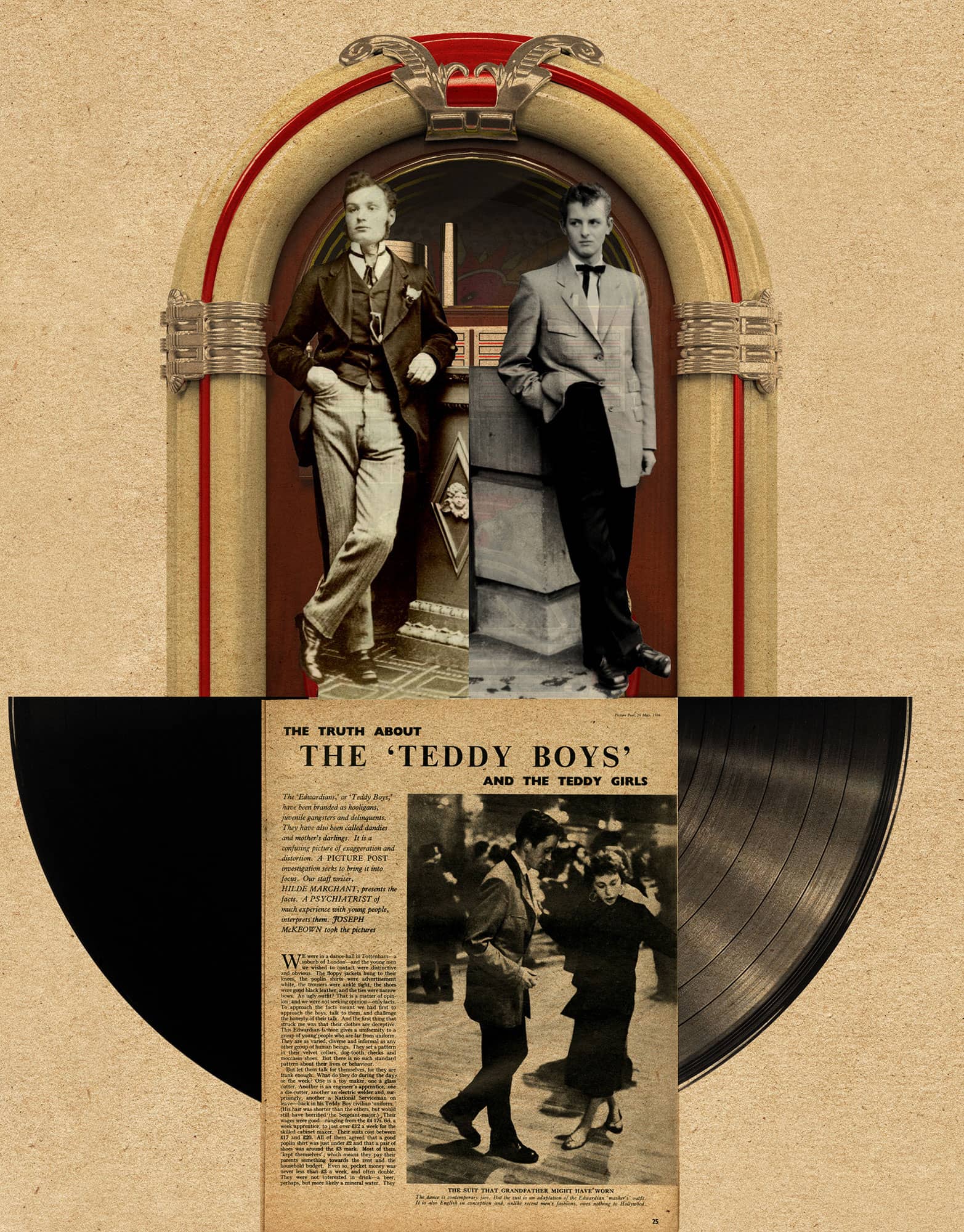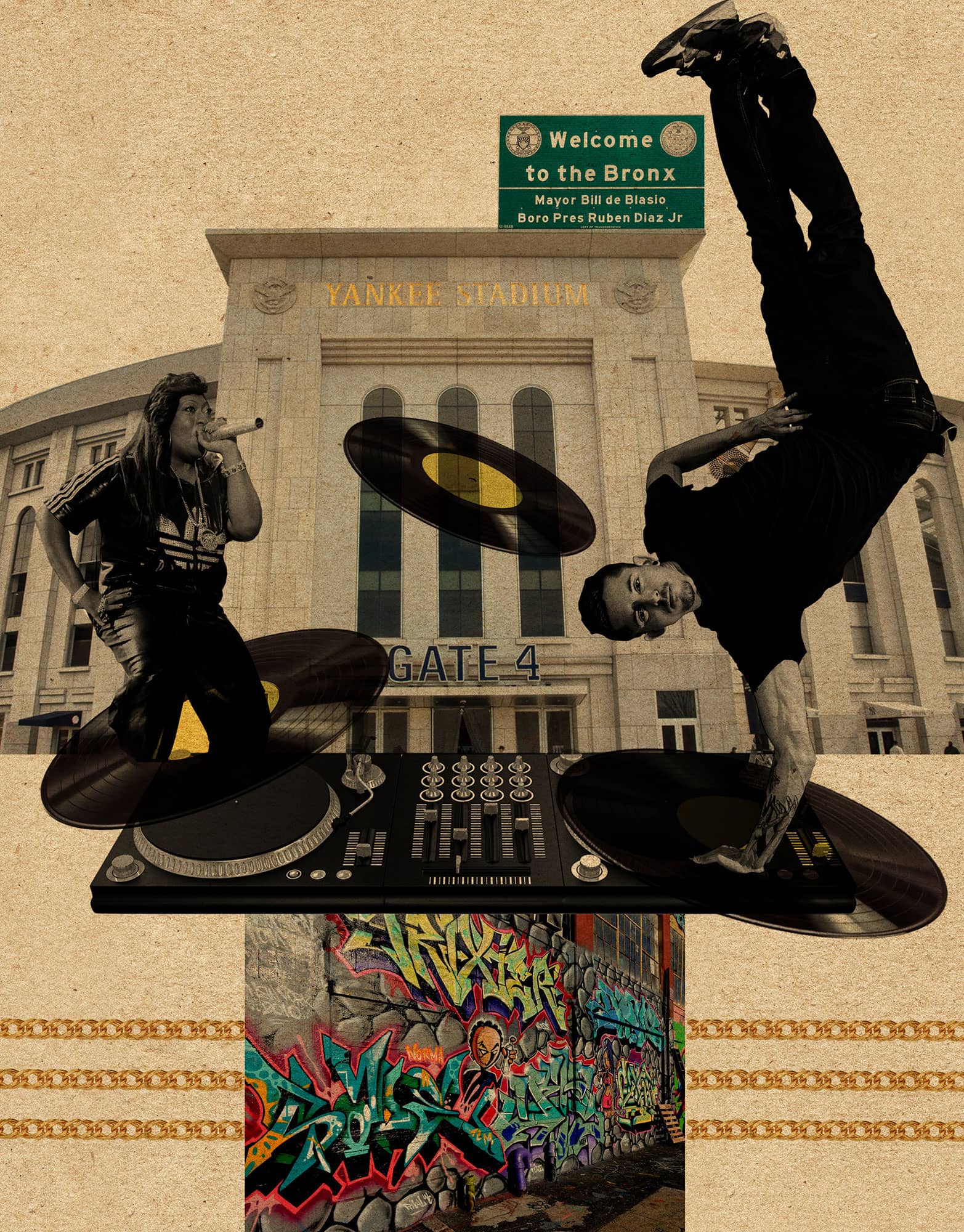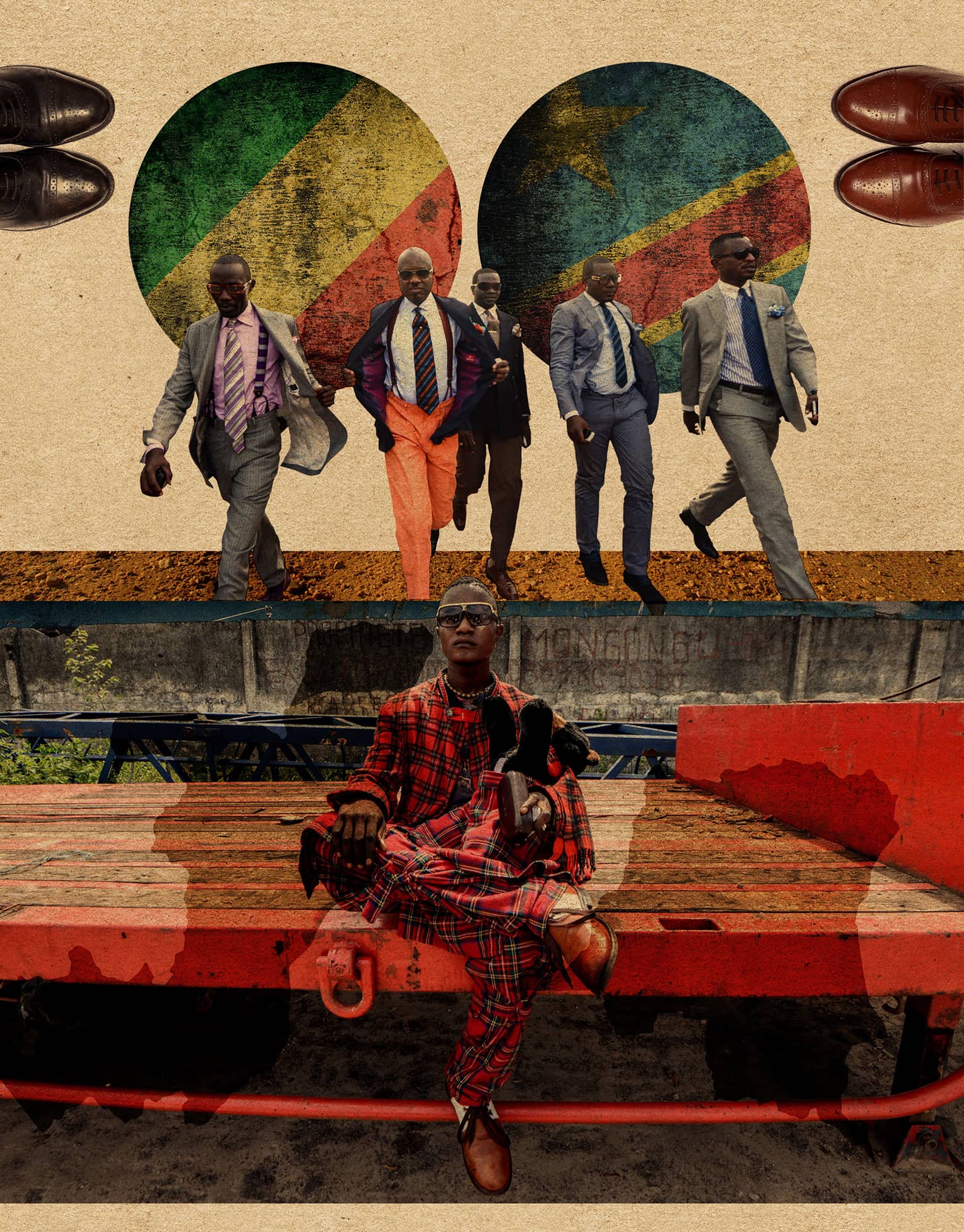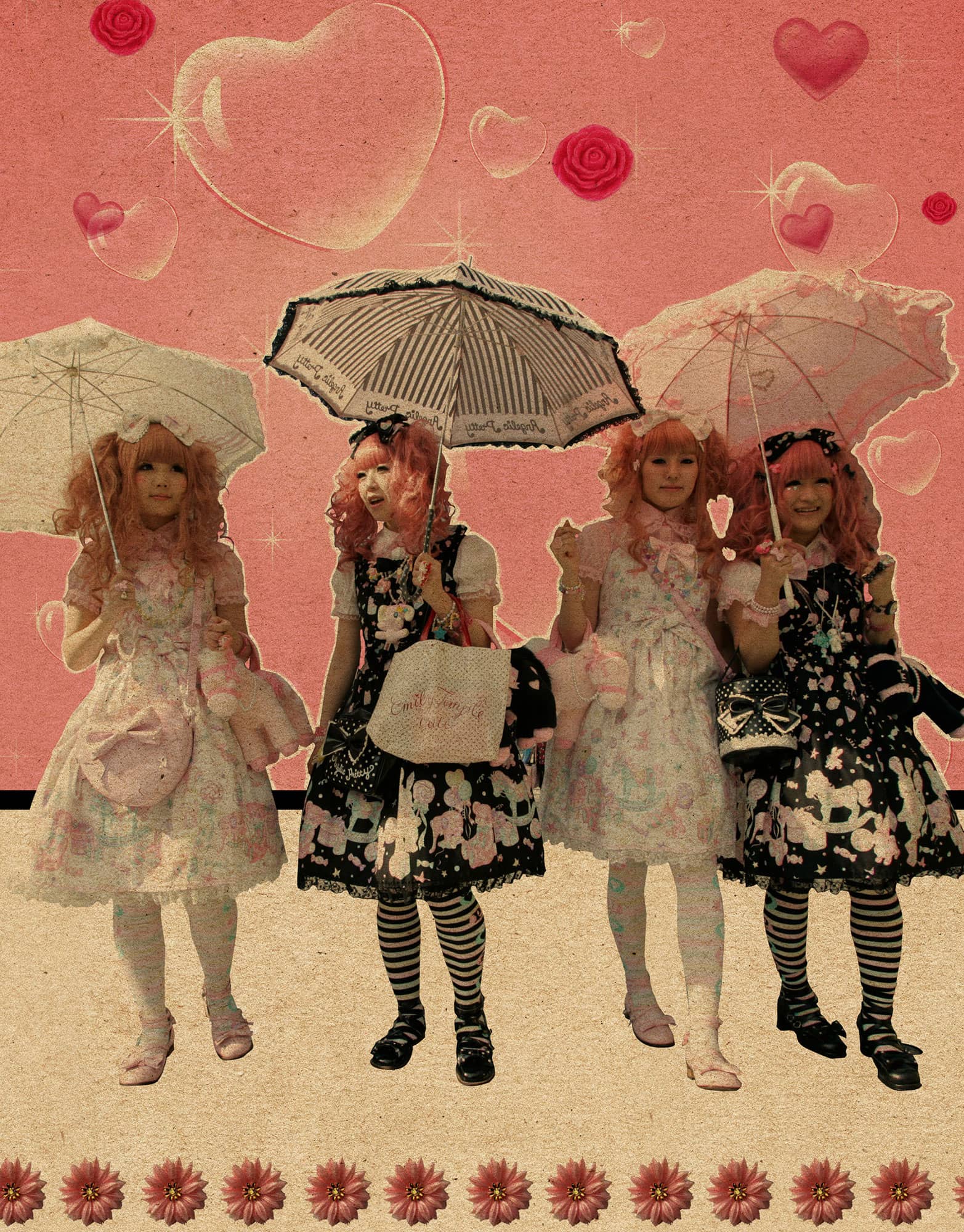
STREET STYLE
STREET STYLE
GLOSSARY
b-boy The b is short for break, as in break dancing, which emerged on the streets of New York in the late 1970s and early 1980s. To engage in competitive dancing in the instrumental breaks of dance tracks, the b-boy style needed tracksuits and sneakers to move in and baseball caps to protect the head, a highly influential look that has continued to evolve as rap and hip-hop hit the mainstream.
brogue Originally rough shoes from Scotland and Ireland, brogues are now associated with a country look and are identified by a decorative pattern of perforated leather across the toe and down the side of the shoe.
dandy A man who affects extreme elegance, often in imitation of aristocratic dressing, or shows excessive concern in his clothing and overall appearance. This can be at some personal cost, whether comfort or economic, or both.
Edwardian Referring to the style and fashions of the Edwardian period, 1901–10, and typified by the elegantly tailored suits of King Edward VII and his fashionable wife Alexandra, who personified Edwardian femininity.
gothic An architectural style prevalent in Europe from the twelfth century and characterized by pointed arches. It is typified by medieval cathedrals and churches such as Sainte-Chapelle in Paris. The gothic revival of the mid-eighteenth and early nineteenth centuries encompassed literature and decorative arts too. Now “gothic” also encompasses melodrama, an element of the supernatural, the grotesque, mystery, and dread, typified by dark clothing and makeup.
MC Short for master of ceremonies or mic controller. Essentially the rapper in hip-hop music, the MC is the person who speaks over the beat, either live or on a recording, while the DJ mixes the beat.
Rococo Originally a French architectural style popular around 1730–50, typified by the extravagant use of sinuous curves and scrolls, which became popular in England in the mid-eighteenth century. The word can also mean florid, excessively detailed, and overly elaborate.
social media An umbrella term for internet media that allows users to interact, share, and exchange information, whether text, video, images, or other multimedia, and create social and professional online networks.
street style Fashion innovations or trends that come from, for example, music or subcultural arenas, that is the “street,” rather than from fashion designers. These may then influence elite and mainstream fashion, for instance, the black leather motorcycle jacket.
subculture A group that has a strong shared outlook and interests that differ from the majority or mainstream culture and can manifest itself, for example, through a combination of fashion, music, and politics.
TEDDY BOYS & GIRLS
Originating in the working class communities of 1950s London, the Teddy Boy subculture emerged in the aftermath of post- war austerity. Deriving their name from an abbreviation of “Edwardian,” the Teddy Boy uniform was inspired by the Edwardian dandies of the early twentieth century: tapered pants, velvet collars, long jackets, vests, and narrow ties. Their distinctive style endeavored to reject the conservative dress of the previous generation and differentiate themselves as a new youth demographic whose financial affluence allowed them to indulge in leisure pursuits, such as movies and music, and wear costly garments. Tight “drainpipe” pants that exposed the socks, soft crepe-soled shoes, and grease-sculpted hair constructed a defiant image of rebelliousness. Imbuing traditional notions of femininity with a new assertive quality, Teddy Girls combined draped jackets and flat shoes with either rolled-up jeans or straight pencil skirts as a sartorial accompaniment to their tough attitude and desire for independence. Although restricted by their lower wages and customary domestic roles, Teddy Girls nonetheless formed Britain’s first female youth subculture. The contemporary media, however, often sensationalized “the Teds,” portraying them as a socially disruptive gang culture.
3-SECOND SKETCH
As the first representatives of British youth culture, Teddy Boys and Girls defined the style of the postwar generation through their rebellious attitude and dress.
3-MINUTE DETAILING
Despite their thoroughly British roots, Teddy Boys and Girls were strongly influenced by the parallel American rock ’n’ roll movement and its iconic figures. Movie stars such as James Dean and Marlon Brando epitomized the rule-breaking spirit at the heart of their modern, rebellious style, while musicians including Elvis Presley and Bill Haley provided the soundtrack central to the Teddy Boy and Girl lifestyle. Later Teddy Girls also adopted the full skirts and neck scarves popularized in 1950s America.
3-SECOND BIOGRAPHIES
JAMES DEAN
1931–55
Actor whose defiant dress and attitude and 1955 movie Rebel Without A Cause influenced the Teddy Boy movement
VIVIENNE WESTWOOD & MALCOLM MCLAREN
1941– & 1946–2010
Design duo whose London boutique temporarily revived the Teddy Boy aesthetic in the 1970s
EXPERT
Julia Rea
Edwardian dandies and American rock ’n’ roll music collided in the defiant aesthetic of the Teddy Boys.

PUNK
Against a background of rising unemployment and economic stagnation, punk was a youth movement that emerged in London and New York in the mid-1970s, as the antithesis to the hippy movement. The London scene was channeled by Malcolm McLaren and Vivienne Westwood, firstly through their boutique SEX, at the unfashionable end of the King’s Road in Chelsea, which sold innovative clothing made from materials such as leather and rubber, and then by the formation of the Sex Pistols in 1975, who also modeled their clothing and were managed by McLaren. Aggressive, anarchic, and perverse, both punk clothing and music set out to shock the older generation. The do-it-yourself approach that underpinned and gave strength to the movement resulted in a highly original look, with various stylistic inspirations, for instance, rocker and skinhead influences drawn together in one look. The customization of items of clothing with studs, holes, graffiti, and rips, often repaired with safety pins, created what were seen at the time as outrageous garments. Punk is still frequently referenced by designers, although Westwood herself has moved on. Perhaps its most important legacy today, however, is its spirit of anarchic collation, drawing together unrelated pieces to form an original look that reflects our personalities.
3-SECOND SKETCH
Originally anarchic, nihilistic, and shocking but also highly original, eclectic, and experimental, punks were unfairly reduced to a stereotype by the media of the time.
3-MINUTE DETAILING
Arguably a precursor to London, the New York scene was influenced by musicians such as Lou Reed and Iggy Pop. McLaren was also briefly manager of the seminal New York Dolls before the formation of the Sex Pistols and the London movement took off. Focused around the CBGB club in Lower Manhattan, bands such as the Ramones, Blondie, the Patti Smith Group, and Television both inspired and drew musical and visual influences from the parallel London scene.
3-SECOND BIOGRAPHIES
DEBORAH HARRY
1945–
Lead singer and songwriter in punk and new wave band Blondie
MALCOLM MCLAREN
1946–2010
Music impresario and one of the initiators of the punk movement in London
PATTI SMITH
1946–
Singer/songwriter whose debut album, Horses, released in 1975, was hugely influential
EXPERT
Alison Toplis
Rude and rebellious, punk clothing countered the mainstream and invited comment.

STREET PHOTOGRAPHY
Many of the most popular street style blogs, such as The Sartorialist, Facehunter, and Coolhunter, feature photographs of real people in urban environments. The aim of their photography shoots is to catch a chance fashion moment that “just happens to be.” However, the history of street photography begins much earlier; the pioneers of the genre are considered to be Eugène Atget, Paul Martin, and Henri Cartier-Bresson who produced arresting depictions of everyday life in the city. Professional fashion photographers, such as Richard Avedon, Norman Parkinson, and David Bailey, also did occasional shoots in the street, but mainly with professional models. Bill Cunningham was one of the first street photographers to make the genre recognizable and widely accepted. In street style blogs the goal is to satisfy a public demand for a more democratic view on fashion by showing ordinary people wearing imaginative outfits in daily life. Visual representation involves snapshot aesthetics rather than carefully arranged fashion scenes. People are not posing and sometimes the view is taken from behind. An opposite trend in street photography relies on the “Straight Up” pose, where the subject faces the camera and is seen from “tip to toe.” This format was first widely used in the British magazine i-D founded by Terry Jones in 1980.
3-SECOND SKETCH
Many street style blogs now evolve into lifestyle sites specializing in cool hunting, their authors representing a new breed of traveler, the “blog-trotter.”
3-MINUTE DETAILING
Blogs on street style effortlessly transgress the boundaries of the social media format. In 2009, Penguin published a best-selling anthology of Facehunter images. Fashion magazines now contain columns on street style. Vogue.co.uk has a section on “street chic”; Style.com includes “Street” with reports from photographer Tommy Ton. Celebrity bloggers collaborate with brands, for example Scott Schuman of The Sartorialist, collaborated with Burberry in the advertising project “Art of the Trench.”
3-SECOND BIOGRAPHIES
SCOTT SCHUMAN
1968–
American blogger and photographer who started The Sartorialist blog in 2005
GARANCE DORÉ
1975–
French street style blogger, illustrator, and photographer who started her blog www.garancedore.fr in 2006
YVAN RODIC
1977–
Swiss blogger and journalist who started his street style blog Facehunter in 2006
EXPERT
Olga Vainshtein
Street photography is now widely used in mainstream fashion journalism.

HIP-HOP
With no singular expression, hip-hop style varies depending on time and artist. Rapper Grandmaster Flash favored leather pants and fringed denim jackets in typical 1970s style. In the late 1980s, Run-D.M.C. popularized tracksuits, gold chains, and Adidas shell toe sneakers. N.W.A., whose music described a grittier urban reality, wore baseball caps and baggy T-shirts emblazoned with the name of their hometown, Compton. From the 1990s onward, artists such as Sean “Puff Daddy” Combs and Ma$e adopted a look that spoke more of luxury and lifestyle, wearing leather suits and chinchilla jackets. Recognizing that fans like to dress like the artists they idolize, Sean Combs and Jay Z parlayed their personal style into the successful sportswear lines Sean John and Rocawear. Luxury brands have influenced hip-hop style—Gucci, Prada, and Versace have all been namechecked in song lyrics—but street style has also trickled up to influence high fashion as many established designers have collaborated and clothed hip-hop’s biggest stars. Tommy Hilfiger famously dressed R&B singer Aaliyah in a top shaped like his logo, and Marc Jacobs asked rapper Kanye West to design a sneaker for Louis Vuitton.
3-SECOND SKETCH
Like the spin of a record, hip-hop influences fashion and then circles back to see itself as a source of inspiration.
3-MINUTE DETAILING
Hip-hop was born at a block party in New York’s South Bronx when an MC first rhymed over a breakbeat to the sound of turntables being scratched. Since 1973, hip-hop has been a cultural movement built by rappers, DJs, b-boys, and graffiti artists. While high fashion looked to capture its likeness and use it to its advantage, entrepreneurial designers such as Harlem’s Dapper Dan made innovative high-end counterfeits bringing Gucci and Louis Vuitton to his loyal clientele.
3-SECOND BIOGRAPHIES
SHAWN CARTER (JAY Z)
1969–
Rapper, producer, and founder of Rocawear clothing line
SEAN COMBS (PUFF DADDY)
1969–
Rapper, producer, and founder of Sean John clothing line
MISSY ELLIOTT
1971–
Songwriter, rapper, and record producer
KANYE WEST
1977–
Influential producer, rapper, and designer
EXPERT
Rebecca Straub
Hip-hop has set music and fashion trends ever since its inception.

SAPEURS
Hailing from Central Africa, Les Sapeurs take their name from the acronym SAPE, meaning Société des Ambianceurs et des Personnes Élégantes. With an attention to menswear details and a taste for tailored suits, Sapeurs wear brightly colored jackets, bowler hats, and brogues. These Congolese men dress in the regalia of European wealth, yet hail from countries—the Democratic Republic of the Congo and the Republic of the Congo—where nearly half of citizens live at or below the national poverty line. The most widely reported origin story cites the advent of SAPE at the end of Belgian and French colonial rule in 1960, when the capitals of Kinshasa and Brazzaville became cosmopolitan centers on opposing sides of the Congo River. Affluent Africans returned from travel with clothing fresh from Europe, creating a taste among the Congolese for Occidental finery. However, when Joseph Mobutu took power and renamed the country Zaire, he implemented a non-Western dress code. In response, Papa Wemba of the popular musical group Viva La Musica began dressing in three-piece suits and polished leather shoes, with many Congolese fans following suit.
3-SECOND SKETCH
Often called modern-day dandies, the Sapeur lifestyle involves more than just the appearance of wealth and stylish clothes—for many, it represents freedom of expression despite political subjugation.
3-MINUTE DETAILING
SAPE has been criticized as a rejection of African tradition in favor of colonial style. Yet the Sapeurs embody a sharply tailored vision of pacifist sophistication rooted in the political and economic hardships faced by Central Africans. An intensified international interest in SAPE is evidenced in the 2012 music video “Losing You” by Solange Knowles, as well as the 2014 Guinness ad campaign, both of which featured members of SAPE, farther spreading their image abroad.
3-SECOND BIOGRAPHY
PAPA WEMBA
1949–
Singer of Viva La Musica, credited with popularizing the Sapeur look
EXPERT
Rebecca Straub
Dressed in polished suits and politically active, the Sapeurs are known for their statement-making sartorial decisions.

LOLITAS
Lolita fashion is a form of Japanese street style that emerged in the late 1980s. Often dismissed as little more than doll-like makeup, ruffles, and lace, it began as a reaction to sexualized representations of women in Japanese culture. It displays an almost confrontational femininity that prizes elegance and modesty over seduction. Lolita fashion can be further categorized by the places from which its wearers draw inspiration. “Sweet Lolita” is the most familiar and oldest form, whose references to Alice in Wonderland—knee-length full skirts, pinafores, and a pastel color palette—characterize the look. “Gothic Lolitas” wear black, burgundy, and white, with garments whose shape and construction reference Victorian corsetry. “Punk Lolitas” employ similar colors to their gothic counterparts, but often as part of a tartan or plaid. Present are the familiar trappings of British punk with safety pins, spikes, and bondage straps appearing frequently in wearers’ outfits. Japanese Lolitas play with traditional forms of dress, referencing samurai armor and wearing kimonos cropped to showcase stockinged legs. Lolita fashion has grown in popularity outside Japan, including the USA, Europe, and South America, where practitioners often make their own clothes, since few stores cater specifically to Lolita sensibilities.
3-SECOND SKETCH
Those dedicated to Lolita fashion often describe it as a lifestyle that extends beyond the mere act of dressing and involves “living beautifully.”
3-MINUTE DETAILING
Many Japanese clothing companies have defined the look of Lolita fashion. The most famous among them, Baby, The Stars Shine Bright, opened in Tokyo in 1988, and offers Sweet Lolita shoppers “light colors and designs inspired by the Rococo era.” Although the flagship store is in Japan, the brand has expanded to include an American store in Manhattan.
EXPERT
Rebecca Straub
Originally a form of Japanese street style, Lolita fashion now has fans and followers across the world.
